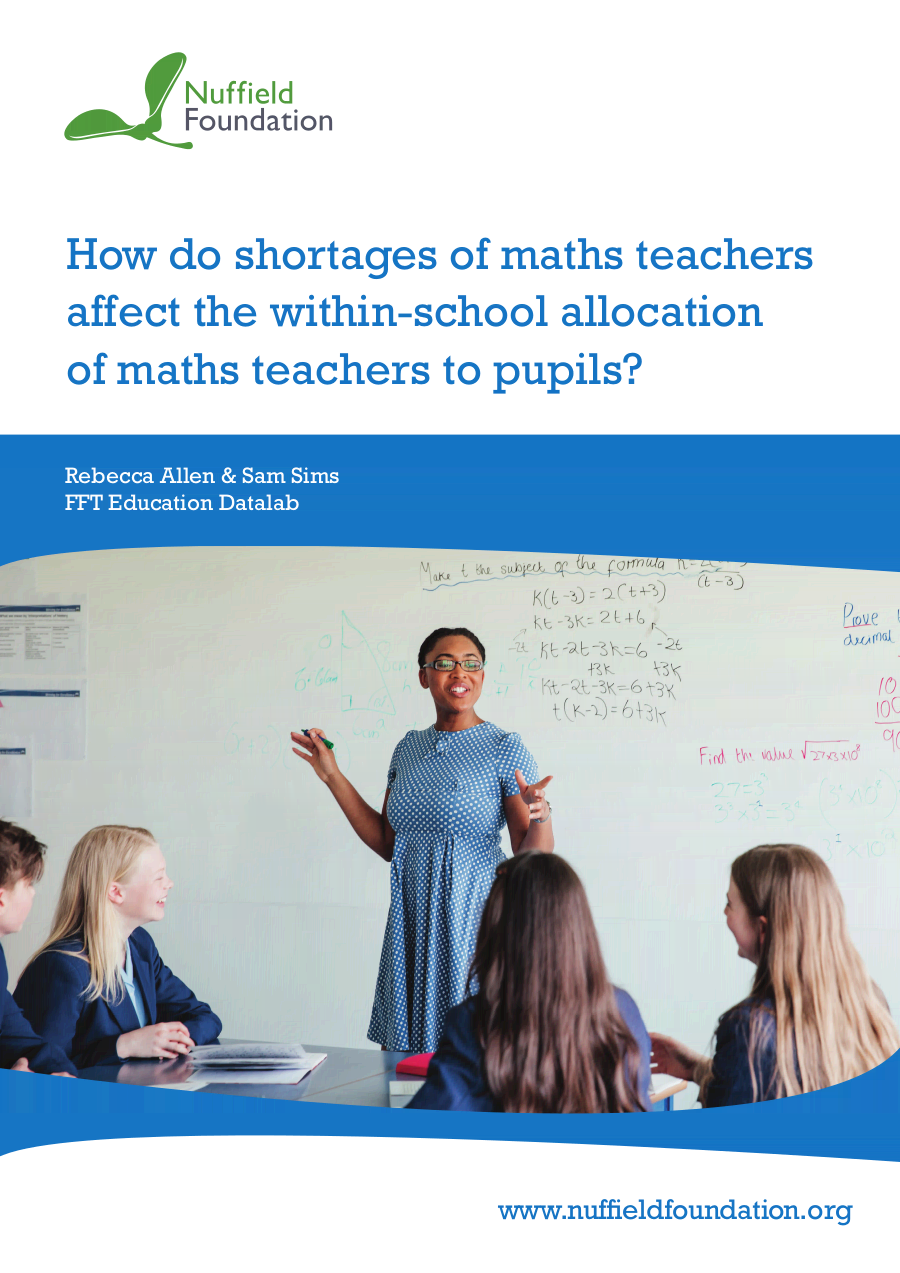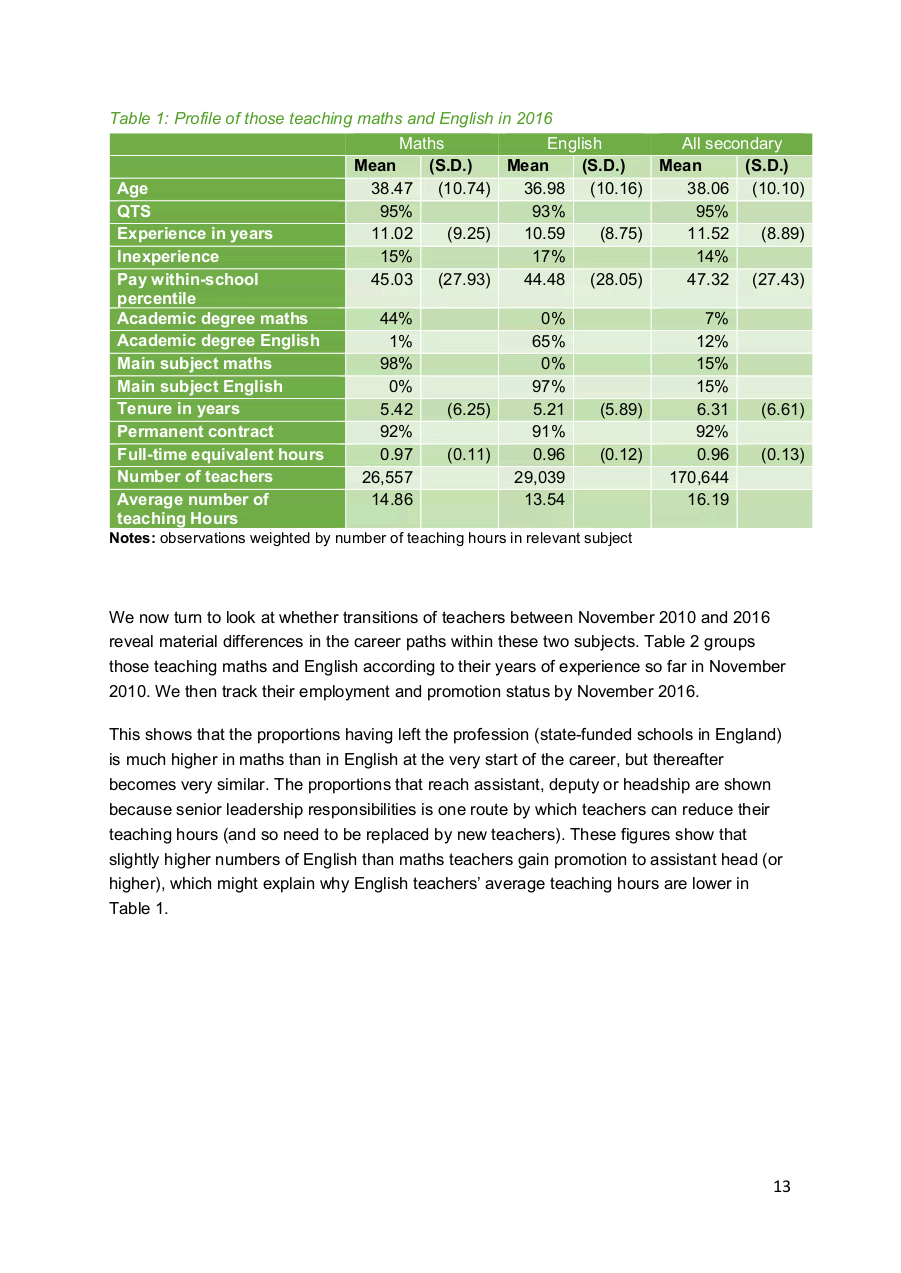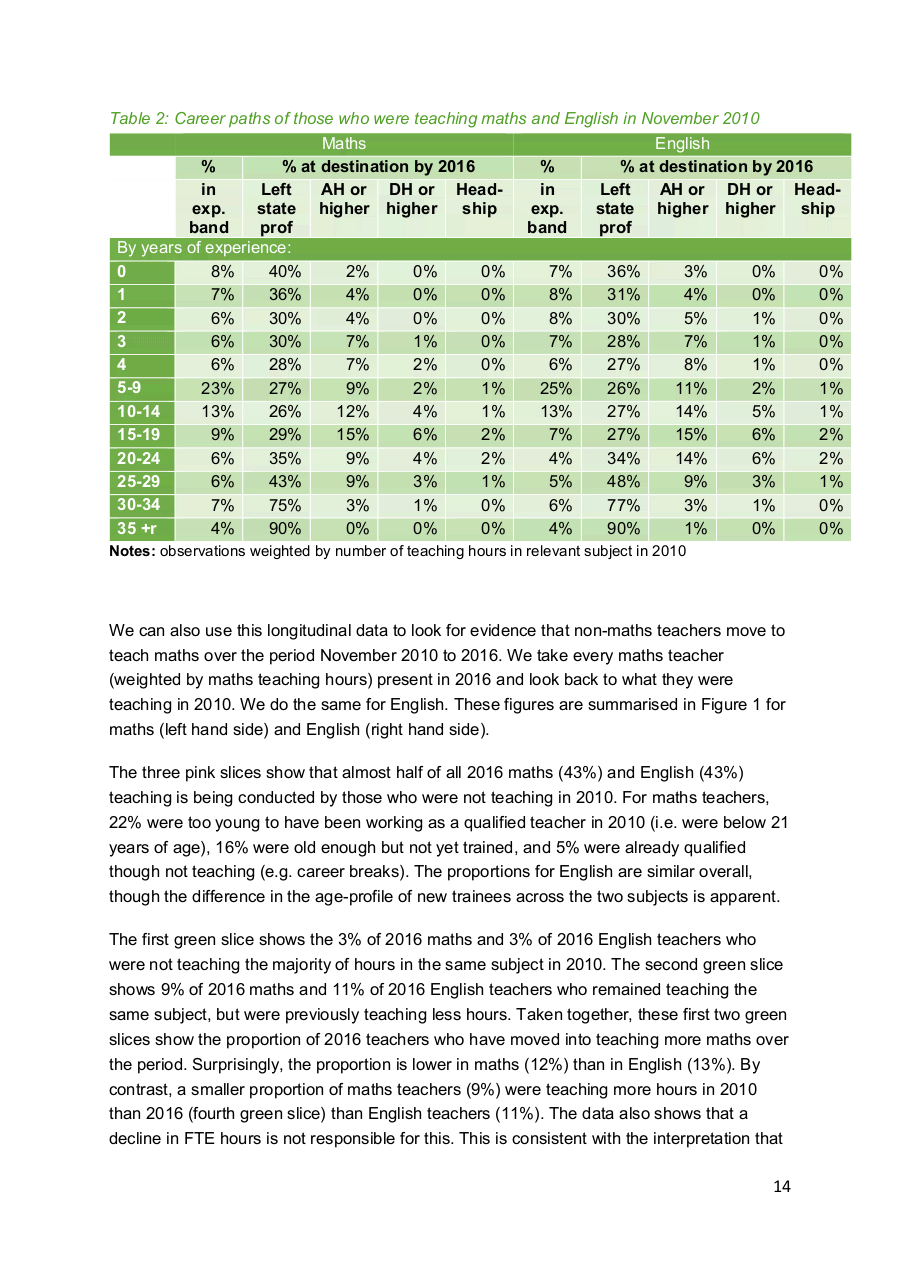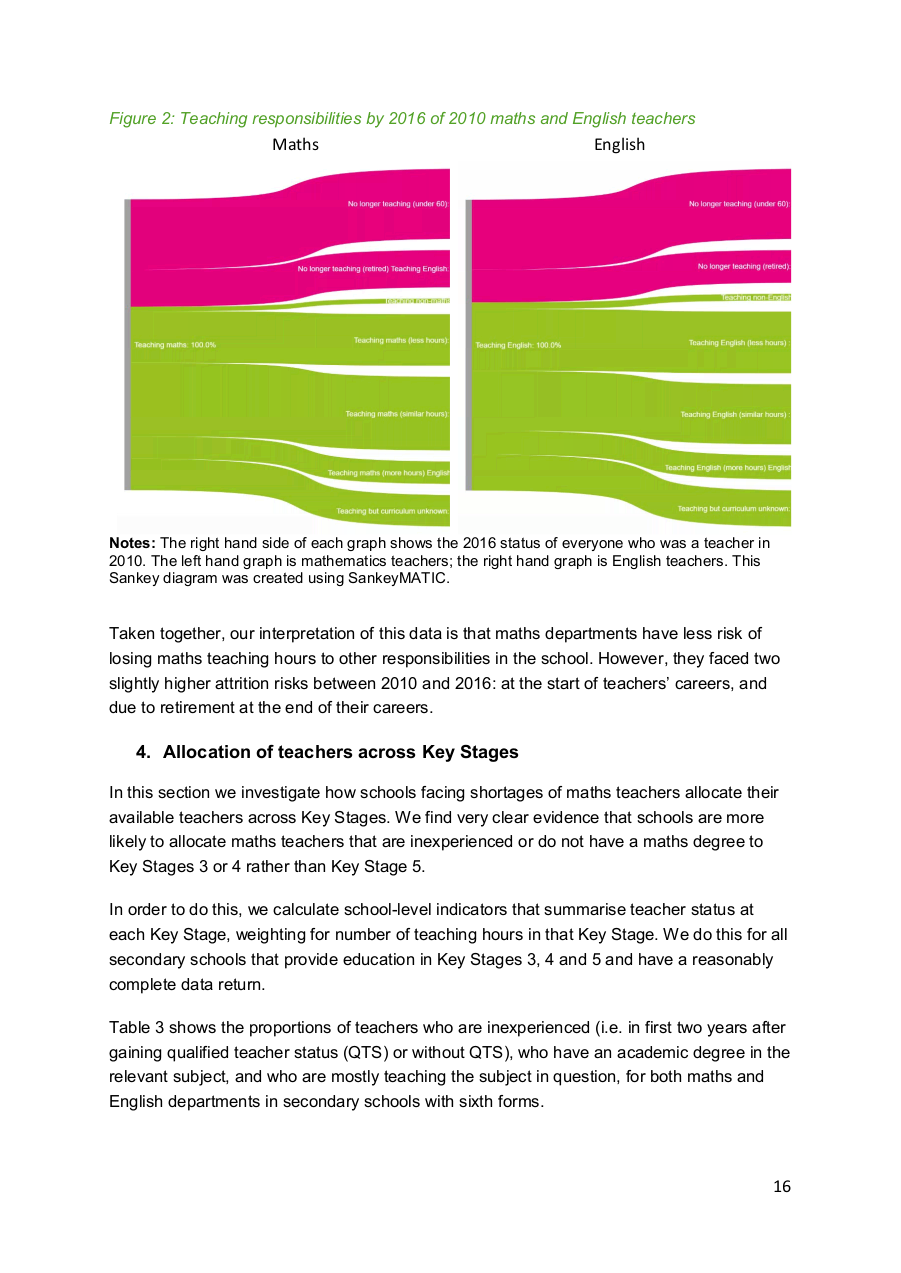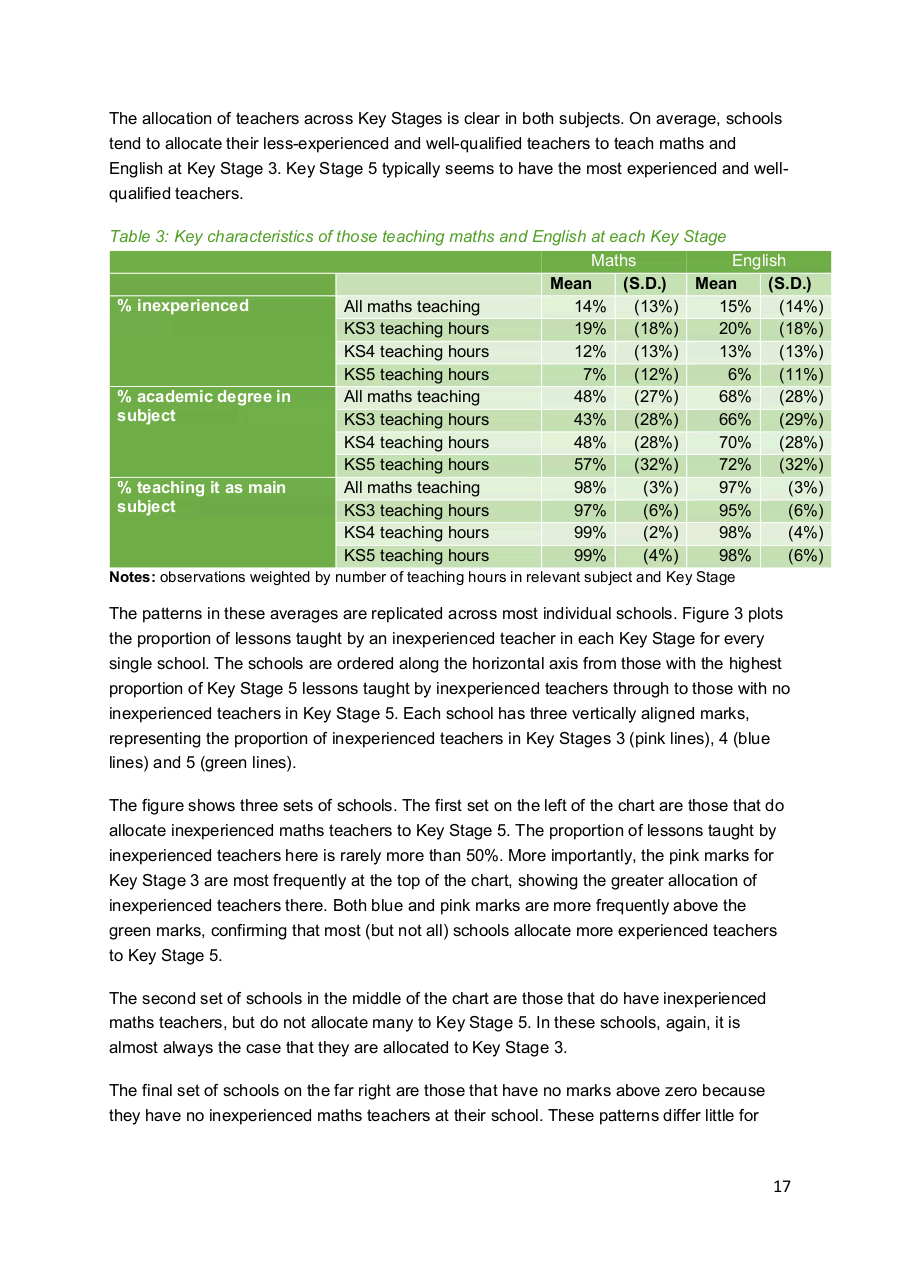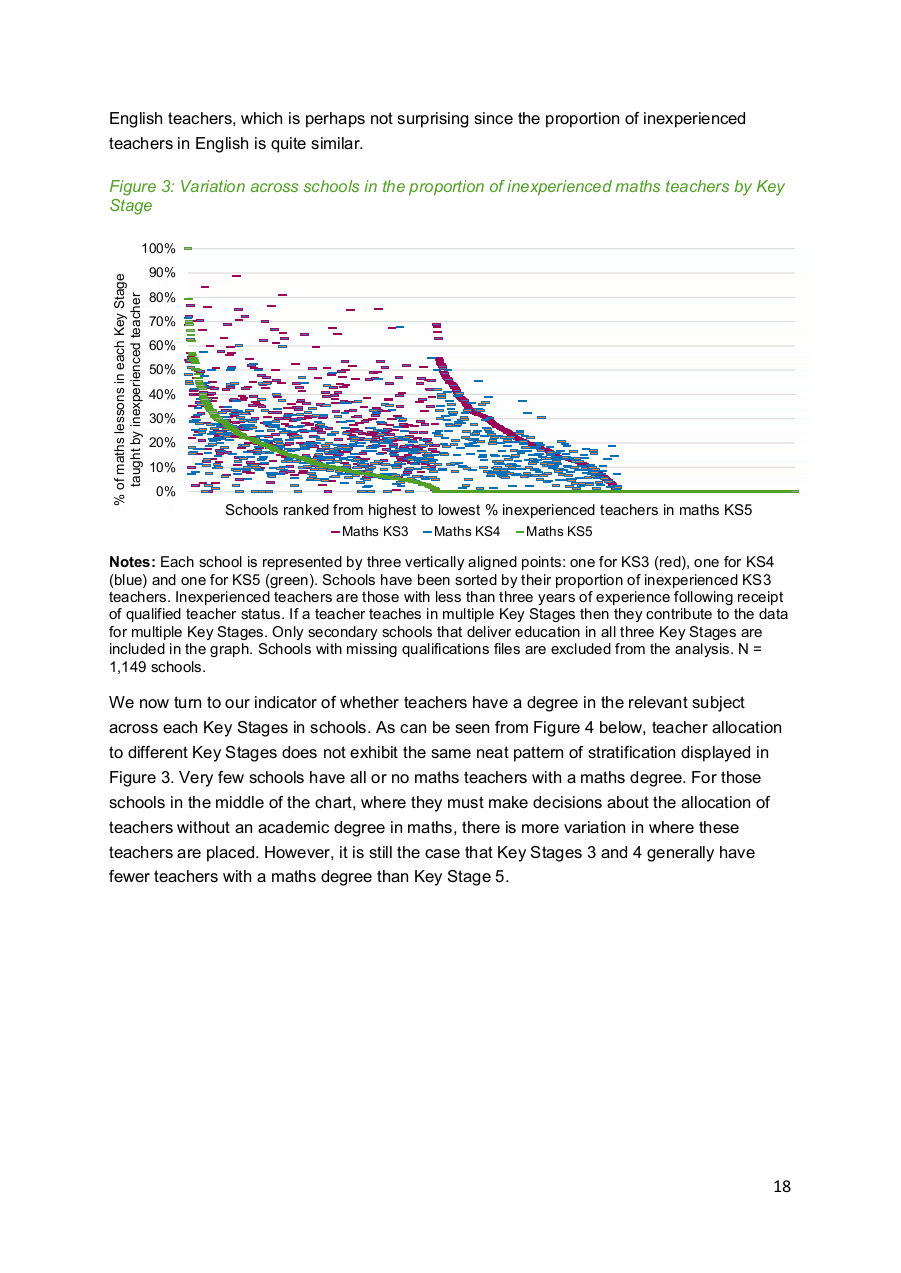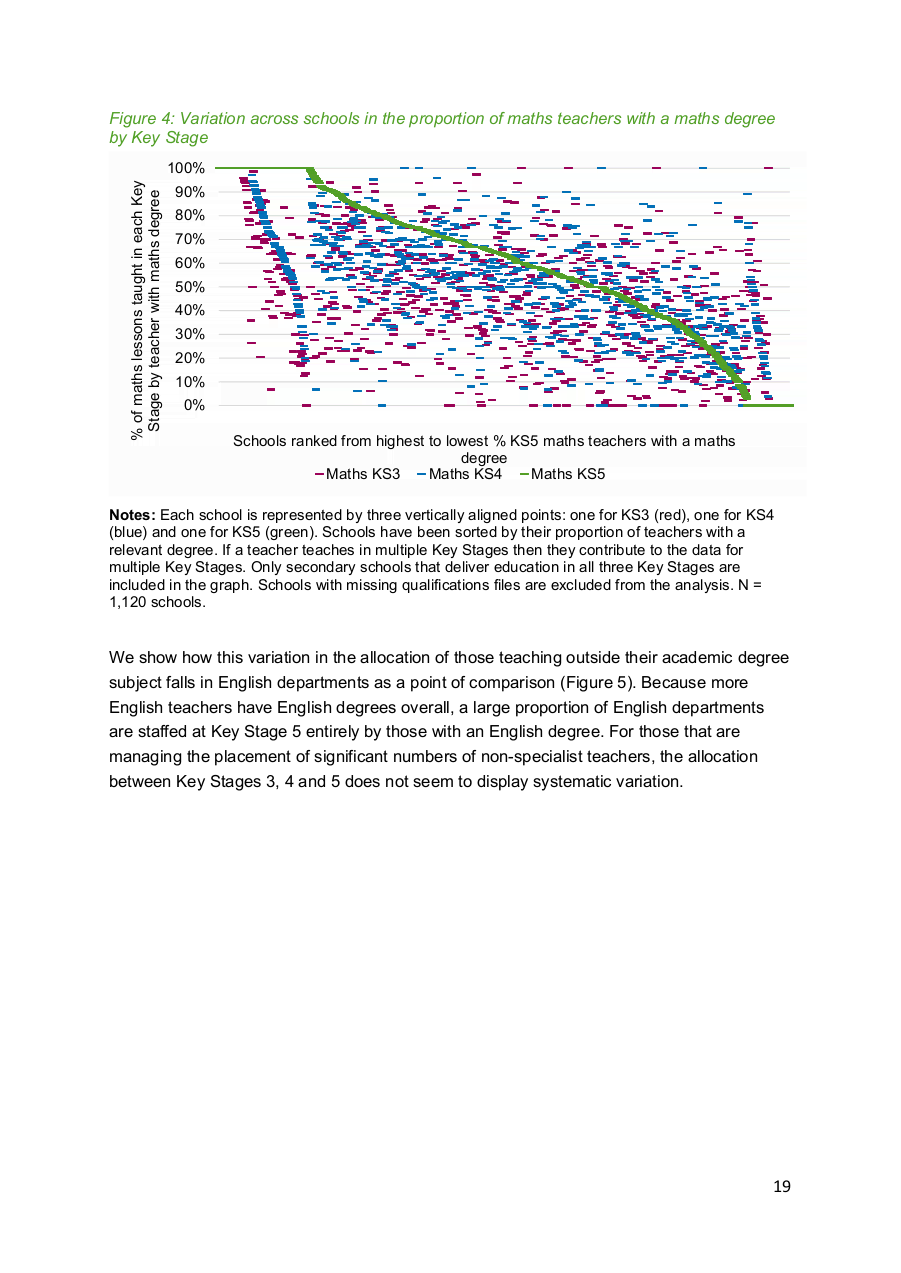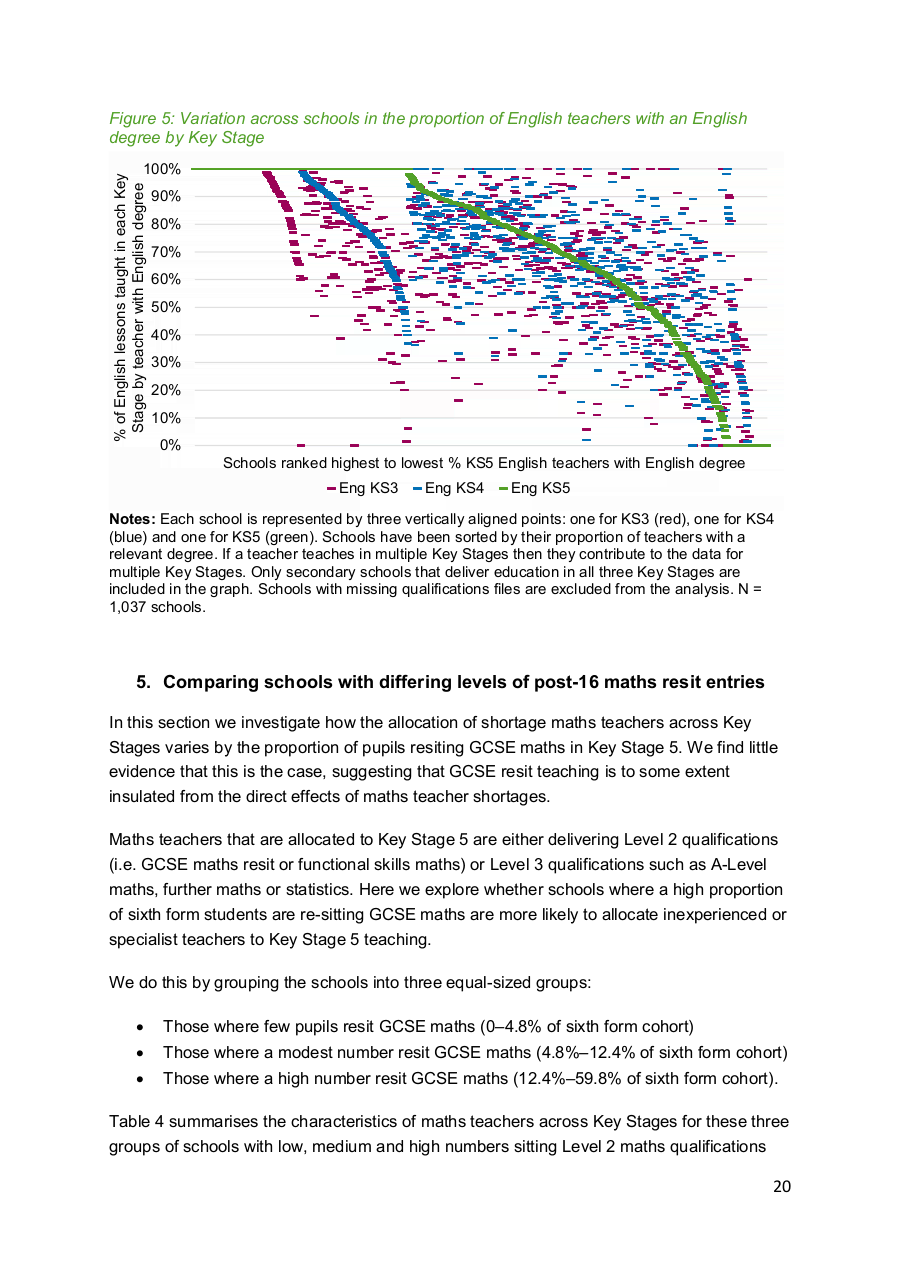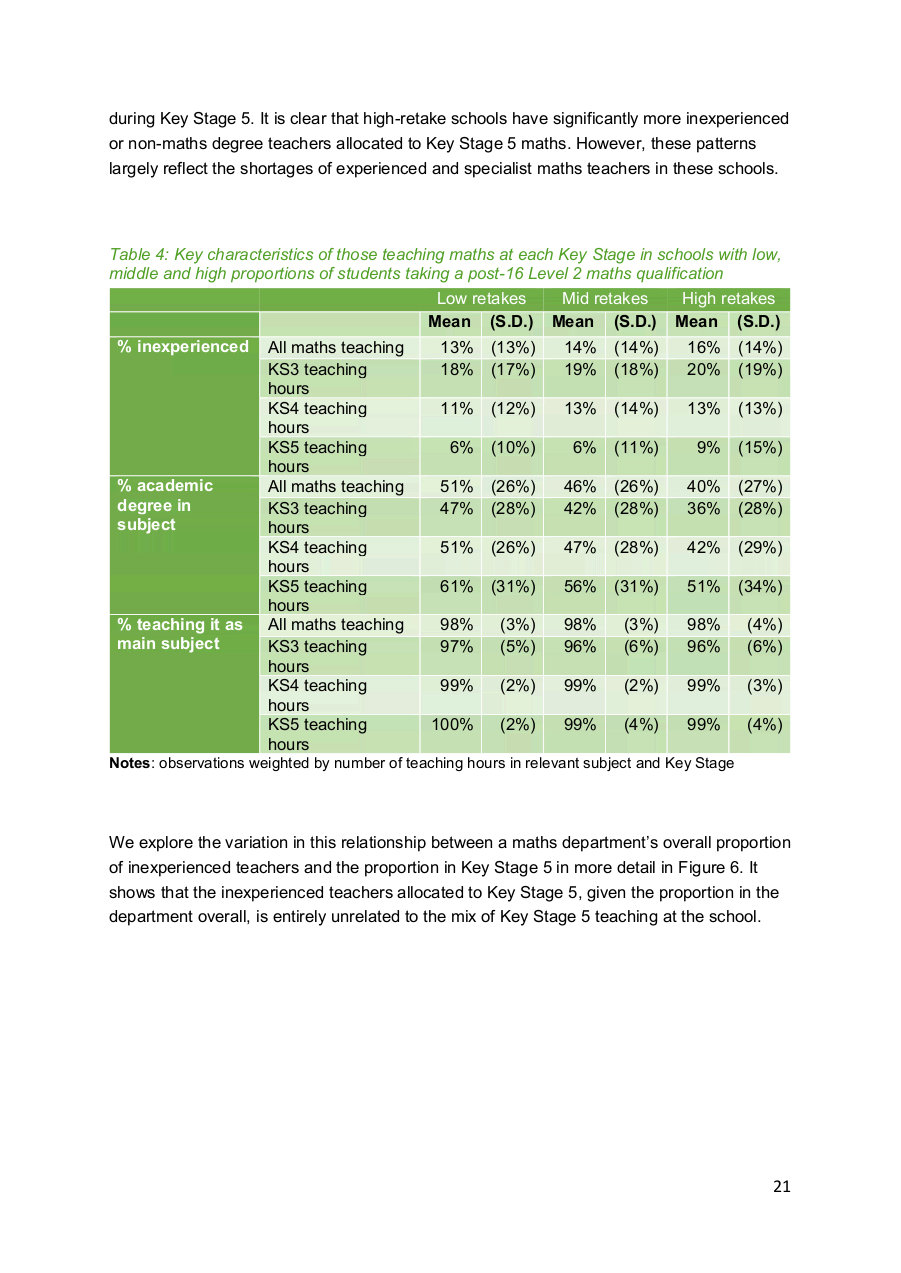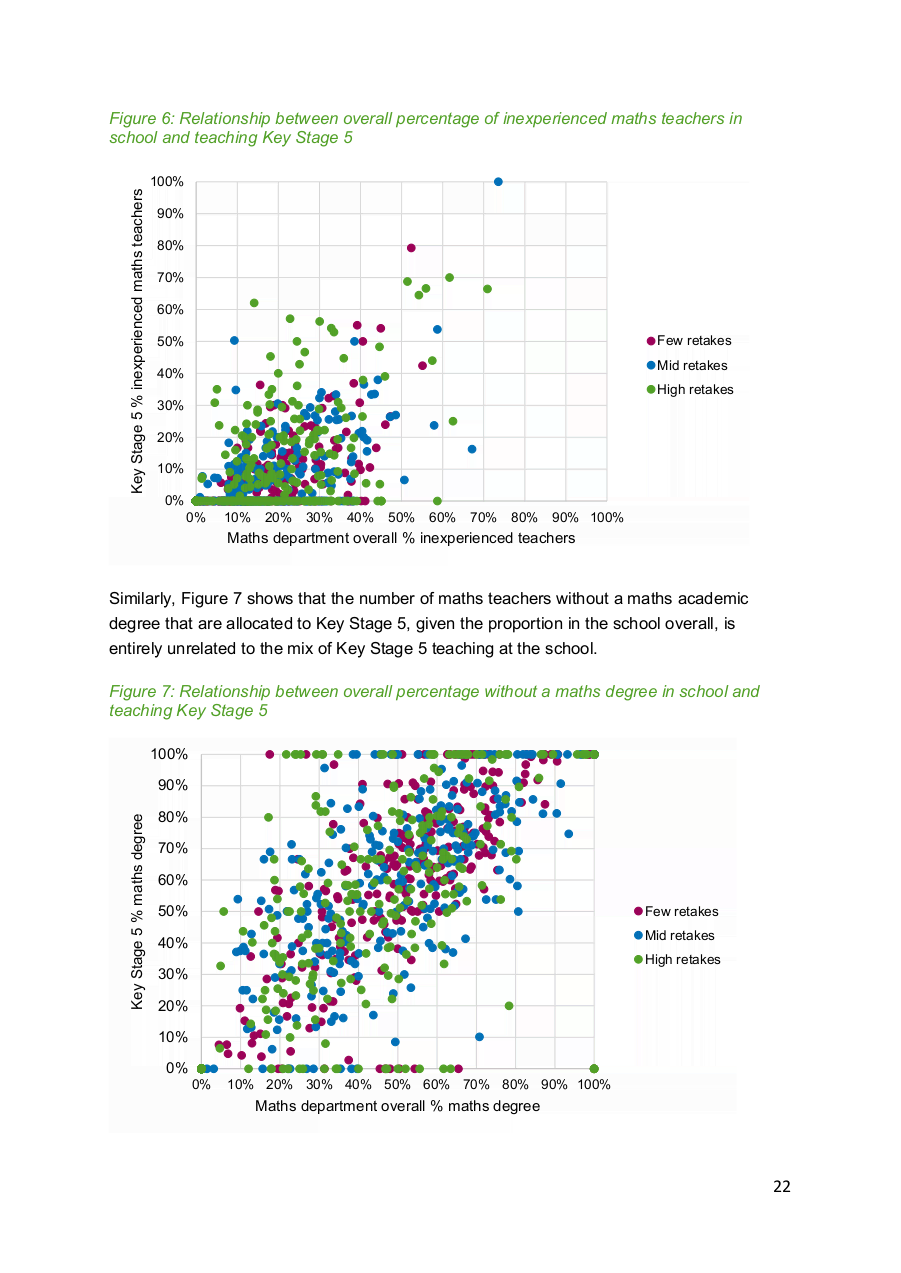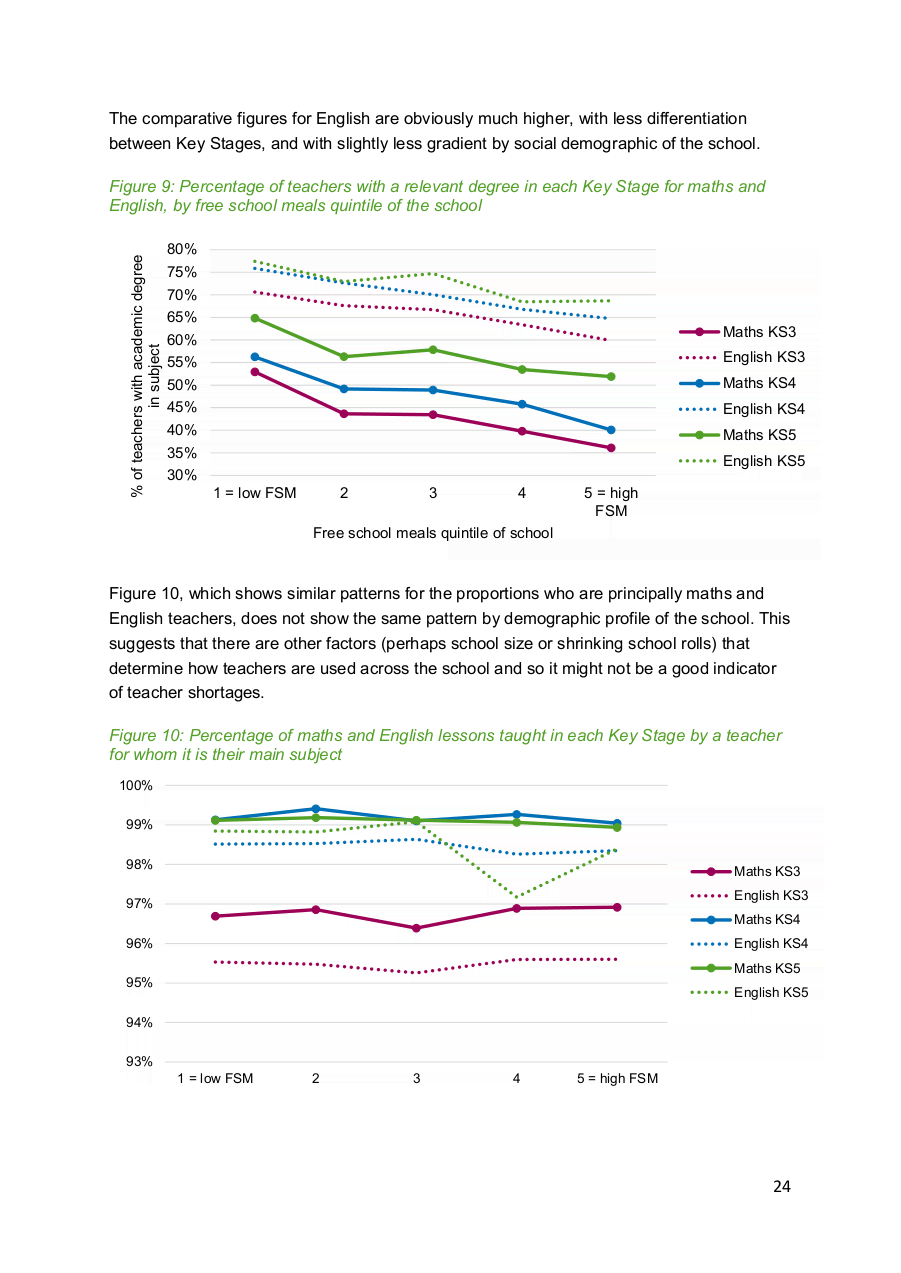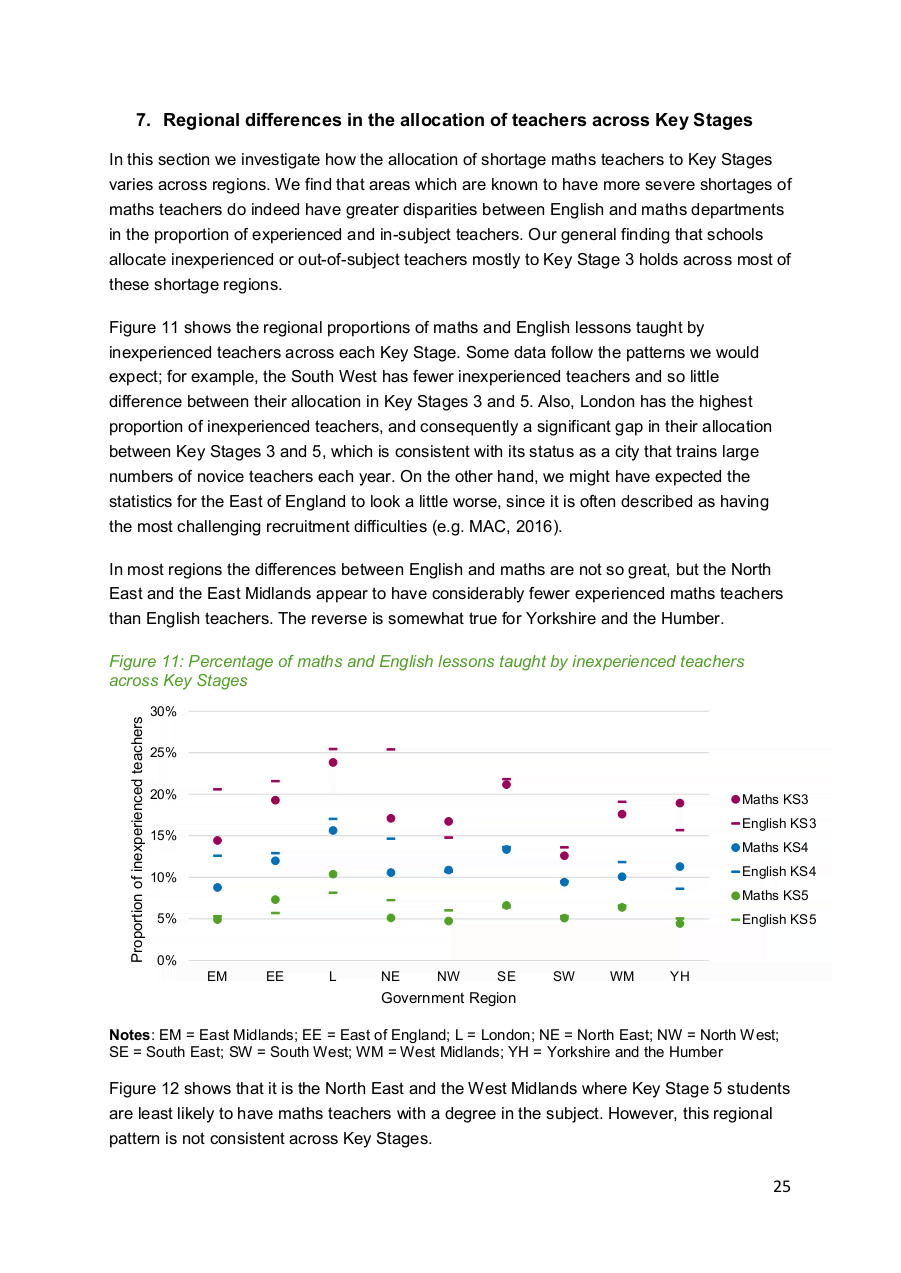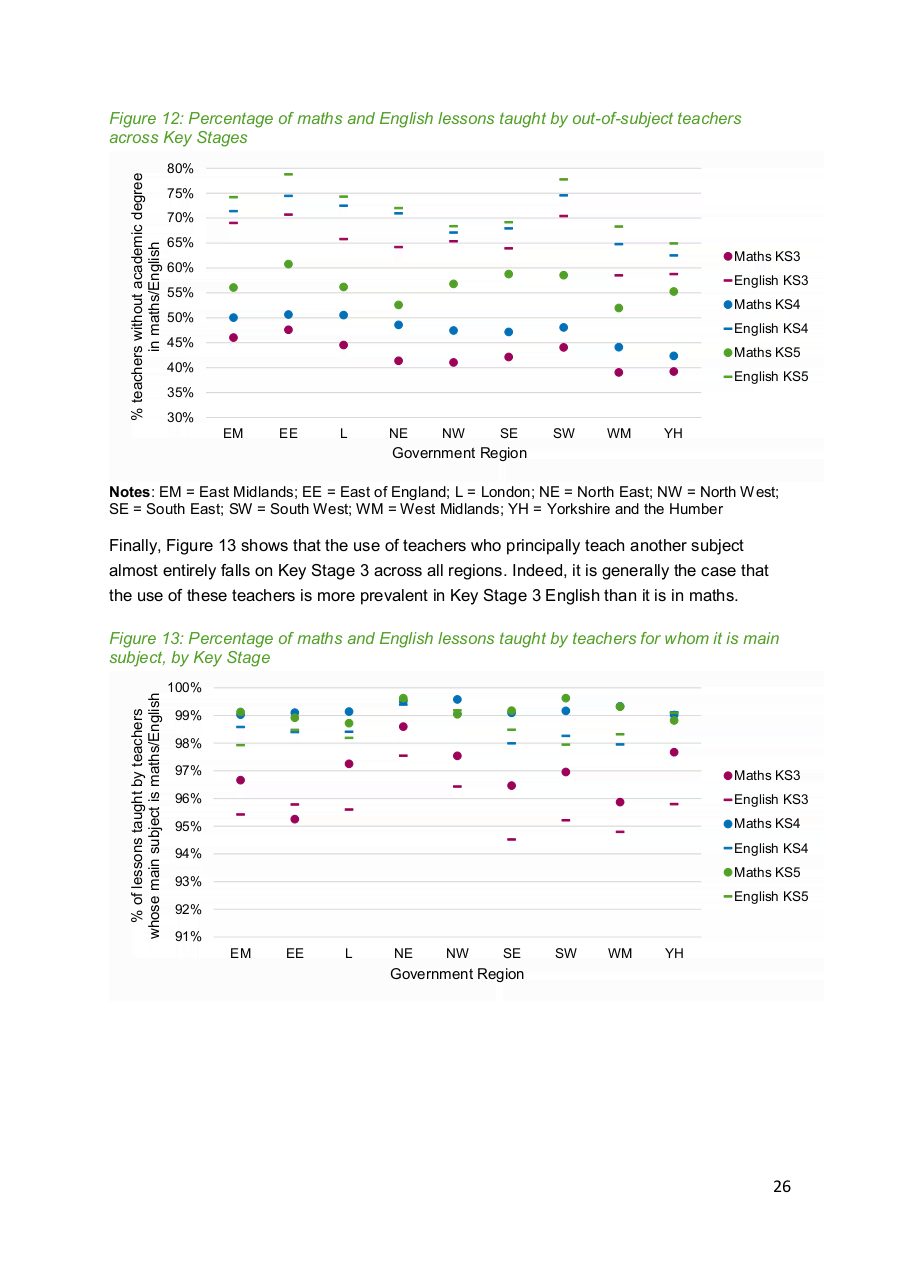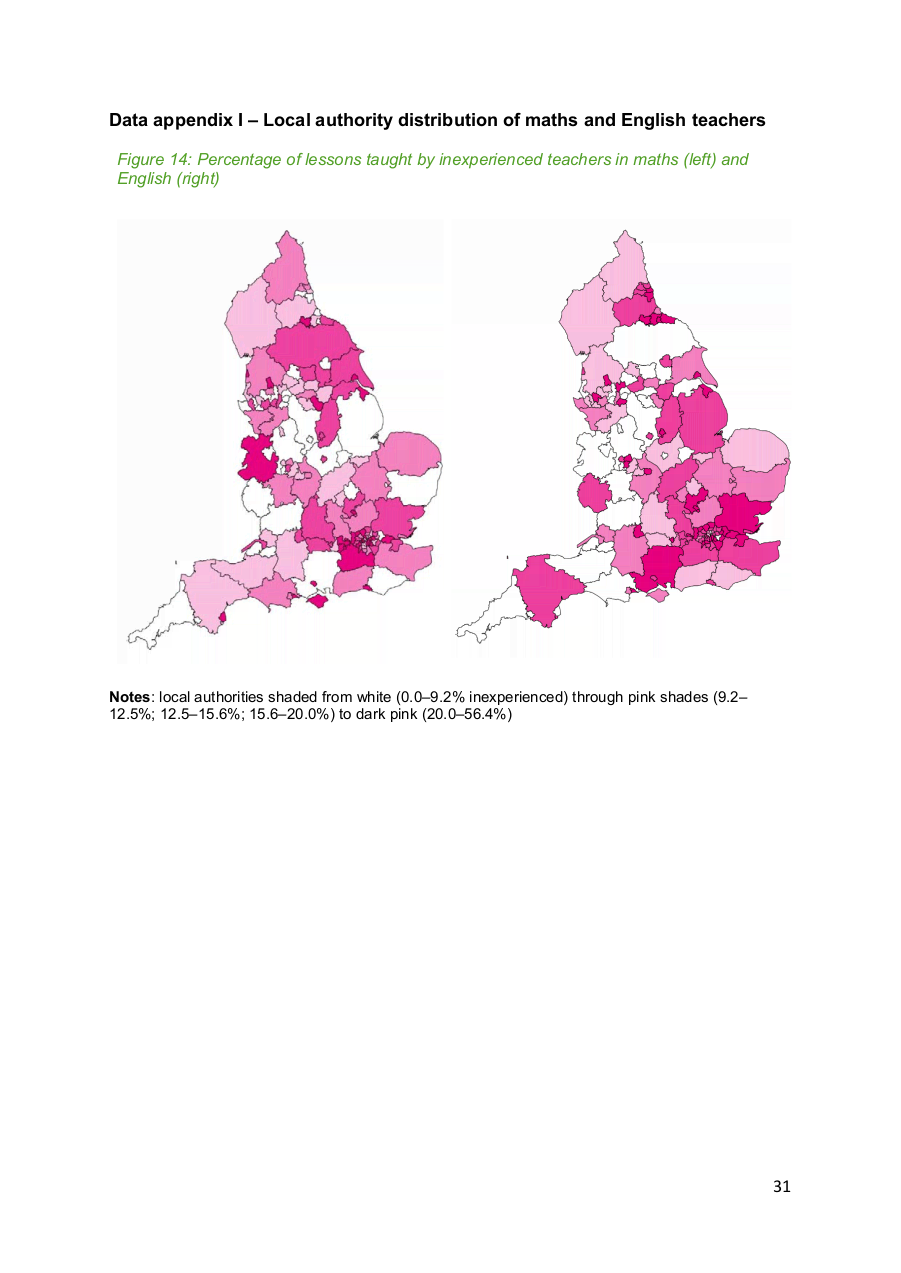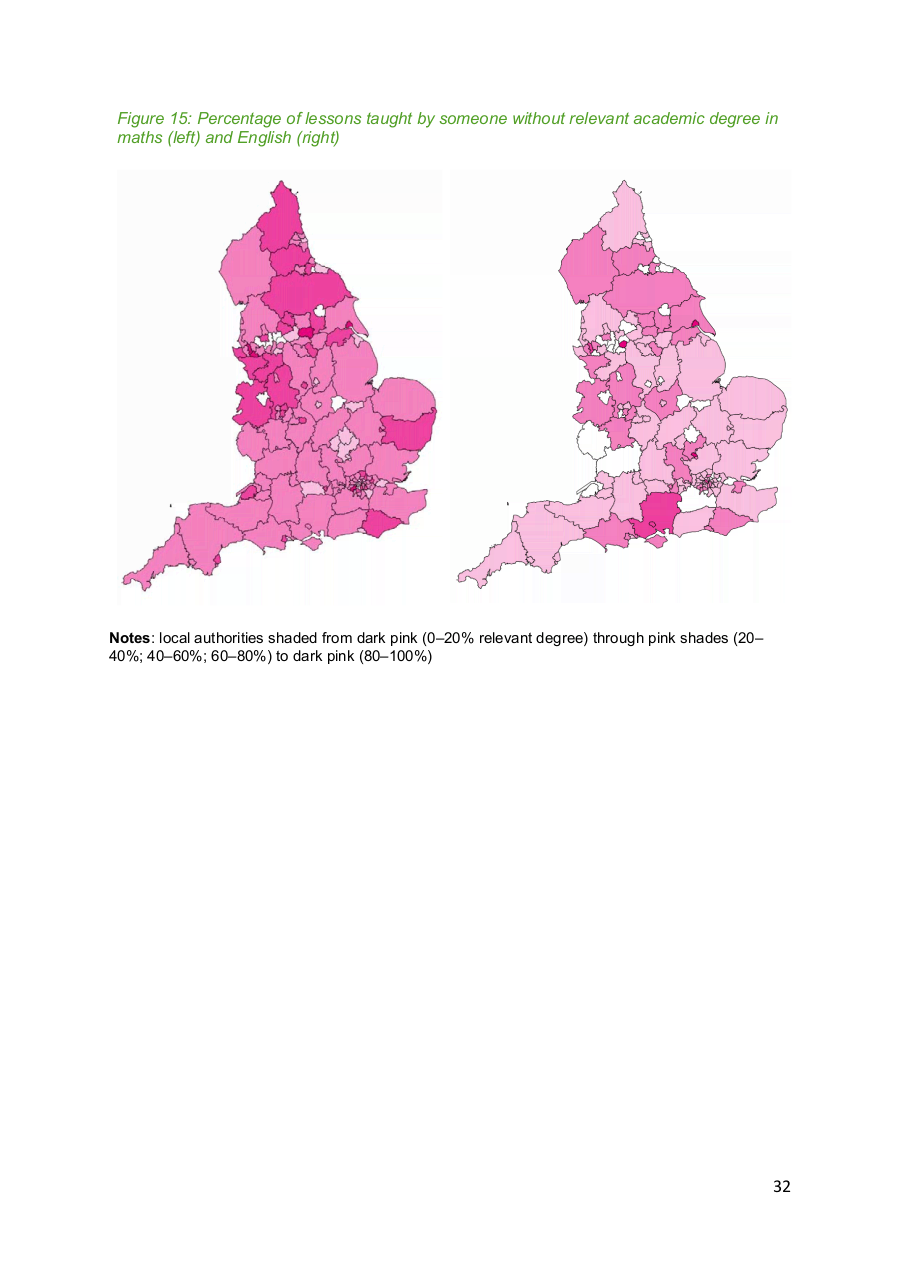Contributed by:
There are currently well-founded concerns about maths teacher shortages in England. The economic recovery has reduced maths teacher supply as employment opportunities have improved in the private sector. At the same time, demand for maths teachers has increased thanks to the requirement for all pupils without an A*–C grade in GCSE maths to continue studying the qualification until the age of 18. Shortages lead to disadvantaged secondary pupils having less access to experienced and well-qualified teachers (Allen & Sims, 2018).
This research addresses two questions. First, how have schools responded to a shortage of maths teachers? Second, can we use these behavioral responses as indicators of school-level maths teacher shortages?
1.
How do shortages of maths teachers
affect the within-school allocation
of maths teachers to pupils?
Rebecca Allen & Sam Sims
FFT Education Datalab
www.nuffieldfoundation.org
2.
About the authors
• Rebecca Allen is an associate research fellow at Education Datalab
• Sam Sims is a researcher at Education Datalab
About this report
This report presents the findings from the Nuffield-funded project to explore how shortages
of maths teachers affect the within-in school allocation of maths teachers to pupils.
It complements the Gatbsy Charitable Goundation report on the profile of the mathematics
teaching workforce in the further education college sector in England (Hayward & Homer,
2015), which was itself part of a collaboration between the two Foundations.
The report is available to download from http://www.nuffieldfoundation.org/reports-and-
About FFT Education DataLab
Education Datalab produce independent, cutting-edge research that can be used by
policymakers to inform education policy, and by schools to improve practice.
About the Nuffield Foundation
The Nuffield Foundation funds research, analysis, and student programmes that advance
educational opportunity and social well-being across the United Kingdom.
We want to improve people’s lives, and their ability to participate in society, by
understanding the social and economic factors that affect their chances in life. The research
we fund aims to improve the design and operation of social policy, particularly in Education,
Welfare, and Justice.
Our student programmes - Nuffield Research Placements and Q-Step - provide opportunities
for individual students, particularly those from disadvantaged backgrounds, to develop their
skills and confidence in quantitative and scientific methods.
We are an independent charitable trust established in 1943 by William Morris, Lord Nuffield,
the founder of Morris Motors.
www.nuffieldfoundation.org | @NuffieldFound
Extracts from this document may be reproduced for non-commercial purposes on condition
that the source is acknowledged.
Copyright © Nuffield Foundation 2018
28 Bedford Square, London WC1B 3JS | Registered charity 206601
1
3.
Tables ................................................................................................................................... 3
Figures .................................................................................................................................. 3
Foreword............................................................................................................................... 5
Executive Summary .............................................................................................................. 7
1. Introduction: Teacher shortages and teacher allocation ................................................. 9
2. Data ............................................................................................................................. 10
3. Comparing the profiles of those teaching maths and English ....................................... 11
4. Allocation of teachers across Key Stages .................................................................... 16
5. Comparing schools with differing levels of post-16 maths resit entries ......................... 20
6. School demographic differences in the allocation of teachers across Key Stages ........ 23
7. Regional differences in the allocation of teachers across Key Stages .......................... 25
8. Conclusion ................................................................................................................... 27
References ......................................................................................................................... 29
Data appendix I – Local authority distribution of maths and English teachers ..................... 31
2
4.
Table 1: Profile of those teaching maths and English in 2016 Error! Bookmark not defined.
Table 2: Career paths of those who were teaching maths and English in November
2010..................................................................................... Error! Bookmark not defined.4
Table 3: Key characteristics of those teaching maths and English at each Key Stage......... 17
Table 4: Key characteristics of those teaching maths at each Key Stage in schools with low,
middle and high proportions of students taking a post-16 Level 2 maths qualification ......... 21
Figure 1: Teaching responsibilities in 2010 of the 2016 cohort of maths and English
teachers ................................................................................. Error! Bookmark not defined.
Figure 2: Teaching responsibilities by 2016 of the 2010 cohort of maths and English
teachers ................................................................................. Error! Bookmark not defined.
Figure 3: Variation across schools in the proportion of inexperienced maths teachers by Key
Stage .................................................................................................................................. 18
Figure 4: Variation across schools in the proportion of maths teachers with a maths degree
by Key Stage ...................................................................................................................... 19
Figure 5: Variation across schools in the proportion of English teachers with an English
degree by Key Stage........................................................................................................... 20
Figure 6: Relationship between overall proportion of inexperienced maths teachers in school
and teaching Key Stage 5 ................................................................................................... 22
Figure 7: Relationship between overall proportion without a maths degree in school and
teaching Key Stage 5 .......................................................................................................... 22
Figure 8: Percentage of inexperienced teachers in each Key Stage for maths and English, by
free school meals quintile of the school ............................................................................... 23
Figure 9: Percentage of teachers with a relevant degree in each Key Stage for maths and
English, by free school meals quintile of the school ............................................................ 24
Figure 10: Percentage of maths and English lessons taught in each Key Stage by a teacher
for whom it is their main subject .......................................................................................... 24
3
5.
Figure 11: Percentage of maths and English lessons taught by inexperienced teachers
across Key Stages .............................................................................................................. 25
Figure 12: Percentage of maths and English lessons taught by out-of-subject teachers
across Key Stages .............................................................................................................. 26
Figure 13: Percentage of maths and English lessons taught by teachers for whom it is main
subject, by Key Stage ......................................................................................................... 26
Figure 14: Percentage of lessons taught by inexperienced teachers in maths (left) and
English (right) ...................................................................................................................... 31
Figure 15: Percentage of lessons taught by someone without relevant academic degree in
maths (left) and English (right) ............................................................................................ 32
4
6.
The Nuffield Foundation has long been a champion for enabling all young people to study
maths beyond the age of 16. Research we have funded has been influential both in
demonstrating the comparatively low rates of participation in England, Wales, and Northern
Ireland, and in developing ways to increase it. Most recently, this influence has been evident
in the development of the new post-16 Core Maths qualification, and in the Smith Review of
post-16 mathematics.
One of the most significant challenges in increasing participation is addressing the shortage
of maths teachers, and we have been keen to understand more about the maths teaching
workforce and issues relating to supply and retention. This report presents analysis of the
ways in which schools have responded to the shortage, using the latest Schools Workforce
Census (SWC).
The analysis presented in this report shows that in broad terms, schools deploy their more
experienced maths teachers with the most relevant qualifications to teach year groups where
the external stakes are high: GCSE, A-Level and GCSE retakes (Key Stages 4 and 5). This
pattern is consistent across all schools, although those in disadvantaged areas are less
likely to have teachers who fit this criteria, meaning that teacher shortages are having the
biggest impact on pupils from disadvantaged backgrounds.
This deployment of more experienced teachers at Key Stage 5, while understandable,
means that the shortage of maths teachers is being felt most keenly at Key Stage 3 (and to
some degree Key Stage 4). At this age, young people’s attitudes to subjects and future study
are crystallising. If maths teaching and learning is not as engaging or tuned to individual
needs as might be desired there are significant risks of adverse effects on pupil outcomes
and progression in those schools struggling to allocate specialist or experienced teachers for
younger year groups.
We should also consider the implications of this analysis for increasing participation in post-
16 maths. We welcome the government’s new advanced maths premium policy, which aims
to increase post-16 participation by offering financial incentives to schools. However, the
potential impact on teachers should also be considered. Putting more pressure on those
already teaching maths at Key Stage 5 may have implications for retaining some of the most
experienced and qualified maths teachers. We would urge government, schools, and the
wider education community to pay close attention to findings from the National Foundation
for Educational Research study into the effect of retention and turnover on the teaching
workforce. Also funded by Nuffield, several outputs from the study have already been
published, showing that long working hours, increased pressure, and lack of options for part-
time and flexible working are all barriers to improving teacher retention.
In considering the analysis presented in this report, it is important to echo the authors’ point
about the limitations of the data it draws upon. While the SWC offers some satisfactory
5
7.
indicators of teacher shortages in schools, it does not provide the fine-grained workforce
data required to fully understand the extent of shortages, the approaches schools take to
managing them, or their impact on student outcomes. This lack of adequate data means we
are limited in the conclusions we can draw, but the authors’ make good suggestions for how
we might collect more, useful data.
Josh Hillman
Director of Education
Nuffield Foundation
6
8.
Executive Summary
There are currently well-founded concerns about maths teacher shortages in England. The
economic recovery has reduced maths teacher supply as employment opportunities have
improved in the private sector. At the same time, demand for maths teachers has increased
thanks to the requirement for all pupils without an A*–C grade in GCSE maths to continue
studying the qualification until the age of 18. Shortages lead to disadvantaged secondary
pupils having less access to experienced and well-qualified teachers (Allen & Sims, 2018).
This research addresses two questions. First, how have schools responded to a shortage of
maths teachers? For example, are they using teachers who trained in other subjects to fill
their staffing gaps in Key Stage 3? Second, can we use these behavioural responses as
indicators of school-level maths teacher shortages.
We use data from England’s School Workforce Census (SWC) 1 to construct a number of
indicators of teacher shortages. We then compare these indicators between maths
departments and English departments to investigate how maths departments have
responded to shortages and to try and quantify the severity of maths teacher shortages in
each school. We use English departments as a benchmark because their curriculum and
qualification structure is similar to maths departments across Key Stages 3 to 5, while
shortages are recognised to be worse in maths than in English (MAC, 2016).
How have schools responded to shortages of maths teachers?
Perhaps surprisingly, we find that many of the characteristics of secondary English and
maths teachers are very similar. We find that those teaching maths are:
• Slightly older and more experienced
• Slightly less likely to be new to the profession or unqualified
• Have similar pay, suggesting similar school responsibilities
• As likely to to be teaching most of their hours in maths, as English teachers are to be
teaching most of their hours in English
• Teaching slightly more hours in maths in total than English teachers do in English,
which means we need 3,500 fewer maths teachers overall
• Much less likely to have a maths degree than English teachers are to have an
English degree.
We compare changes in who is teaching maths and English between 2010 and 2016 to
explore how teaching responsibilities change over teachers’ careers. Overall, this analysis
shows that maths departments are less at risk of losing maths teaching hours to other school
responsibilities, such as promotions to leadership roles. However, maths departments face
two slightly higher attrition risks: new maths teachers are slightly more likely to leave the
https://www.gov.uk/education/school-workforce-censuses
7
9.
profession than English teachers, perhaps because they are older; and maths departments
have slightly higher numbers due for retirement soon.
The clearest conclusion from our analysis of how maths departments manage teacher
shortages is that, where there are teachers who are inexperienced or do not have a degree
in the subject, they are most frequently allocated to teach Key Stage 3 classes. This is true
regardless of whether the school’s sixth form is delivering a large number of GCSE retake
classes or not. Thus, it would seem that maths and English Heads of Department both place
a value on ensuring that experienced and well-qualified teachers are delivering the GCSE
retake and A Level (or equivalent) classes. Post-16 maths therefore seems to be insulated
from direct harm by shortages of maths teachers, though of course if pupils arrive ill-
prepared from Key Stage 3, this will have knock-on effects.
Can the staffing patterns of maths departments be used to quantify school-level
shortages of maths teachers?
We construct three proxies for school-level maths teacher shortages: proportion of
inexperienced teachers (having taught for less than two years); teachers without a relevant
academic degree; and proportion of teaching hours delivered by a teacher outside their main
subject. The first two of these proxies reproduce known patterns of teacher shortages,
across regions and socio-economic groups. The third is less successful.
Overall, we conclude that metrics from the SWC, such as teacher inexperience or mis-
matched academic degree, provided satisfactory, but rather blunt, indicators of teacher
shortages in schools. In contrast to metrics such as applications per post, appointable
applicants interviewed and headteacher perceptions of quality of applicants, they do not
provide direct measures of school-level teacher shortages. If we are to understand how
maths teacher shortages are affecting the education of children across schools and year
groups then it will be necessary to collect this sort of data through e.g. an annual survey of
8
10.
1. Introduction: Teacher shortages and teacher allocation
Having a good teacher has an important impact on pupil attainment (Hanushek & Rivkin, 2012),
particularly for pupils from disadvantaged households (Hamre & Pianta, 2005; Slater et al.,
2012). The benefits of having access to good teachers can also be detected in pupils’
earnings as adults (Chetty et al., 2014). Moreover, the variation in teacher effectiveness
appears to be particularly marked in mathematics (Burgess, 2015). It is therefore critical that
schools are able to recruit, develop and retain good maths teachers.
Unfortunately, England has had an overall shortage of maths teachers since the 2012/13
academic year and severe shortages since the 2016/17 academic year (Sims, 2017).
Indeed, a recent government report identified maths as having among the worst shortages of
any subject (MAC, 2016). According to the Times Educational Supplement, which creates an
index of success in appointing a teacher from their jobs portal and survey data, maths has
been the most difficult subject to appoint to in every year since its index started in 2011 (TES
Global, 2016). 2
On the supply side, the shortage of maths teachers is in part accounted for by economic
recovery (Chevalier et al., 2007) combined with the higher private sector wages available for
those with a maths degree (MAC, 2016). This is consistent with maths and science teachers
having among the highest rates of early-career attrition (Worth and De Lazzari, 2017). On
the demand side, the shortage of maths teachers has been exacerbated by policy changes
which have made it mandatory for all pupils without an A*–C grade in GCSE maths to
continue studying the qualification until the age of 18 (Smith, 2017). There is also some
evidence that the new GCSEs and Progress 8 accountability metric have caused many
schools to increase maths and English timetables in Key Stages 4 and 3 (Worth and De
Lazzari, 2017). Shortages appear to be concentrated in particular schools rather than
particular regions (Department for Education, 2017), most likely because these schools are
characterised by poor working conditions (Sims, 2017; Allen & Sims, 2018).
These shortages result in the sub-optimal recruitment and deployment of teachers. For
example, survey research shows that school leaders respond to such shortages by making
increased use of temporary teachers, lowering recruitment standards or increasing class
sizes (Smithers & Robinson, 2000; Moor et al., 2006). In general, there is substantial
variation in the quality of teachers within schools, as well as between schools (Hanushek &
Rivkin, 2010). By allocating teachers to certain phases, Key Stages (International Standard
Classification of Education (ISCED) levels) or ability groups, middle and senior leaders
therefore determine which pupils get access to the best teachers and, by extension, which of
them will make the most progress. During teacher shortages, these choices become more
stark, for more schools.
Although note that English is also not particularly good in terms of recruitment.
9
11.
There is a growing literature on the allocation of teachers to pupils within schools. The first
strand of the literature has looked at which pupils get access to high quality teachers. Three
studies from the US (Kalogrides et al., 2012; Loeb et al., 2012; Grissom et al., 2015) have
found that classes containing disadvantaged pupils are more likely to get inexperienced or
less qualified teachers. In England, two comparable studies have been conducted; one
found that teachers with no post-compulsory qualifications in maths were more likely to be
allocated to low-ability sets (Moor et al., 2006), and the other found that classes containing
disadvantaged pupils were more likely to have inexperienced teachers (Allen & Sims, 2018).
In the US, three studies have used direct measures of teachers’ ability to improve
attainment, and all three found that classes with disadvantaged pupils are slightly less likely
to get teachers with high value-added scores (Sass et al., 2010; Isenberg et al., 2013;
Mansfield, 2015). The second strand of the literature has looked at how schools respond to
accountability incentives in allocating their teachers. For example, Boyd et al. (2008) show
that the introduction of a fourth-grade examination, the results of which would be used in
accountability measures, led schools to reallocate their experienced teachers to fourth-grade
In this paper, we use a number of indicators of teacher shortages to identify which schools
are struggling to recruit and retain maths teachers. We then investigate how schools are
allocating their maths teachers to different Key Stages. We find that inexperienced and out-
of-subject maths teachers are much more likely to be allocated to Key Stage 3 than Key
Stages 4 or 5. This finding holds across most regions of the country and irrespective of the
level of pupils resitting maths GCSE during Key Stage 5. The pattern is particularly marked
in schools with higher levels of deprivation.
2. Data
Our analysis uses data from England’s School Workforce Census (SWC). This is a large
administrative dataset which contains demographic, employment, absence, curriculum and
qualification data on all teachers working in English state schools since 2010/11. The
majority of the analysis in this paper uses the November 2016 Census, though we also use
data from November 2010 to analyse changes in teacher timetables.
Throughout the analysis we compare teachers of maths to teachers of English. We include
all teachers of these subjects, even if they only teach one lesson a week. In the first part of
our analysis, we explore the demographic and career characteristics for all maths and
English teachers that we can identify (unfortunately a minority of schools do not submit
accurate curriculum data). In the second part of our analysis, we restrict the sample to
schools with students in Key Stages 3, 4 and 5, where we are reasonably confident that the
curriculum file is complete. We do this by dropping all schools without a sixth form and those
schools who have unusually low or high maths or English teacher-to-pupil ratios at Key
Stage 3 or 4. This leaves us with 1,149 schools included in our main analysis.
10
12.
We cannot observe teacher shortages in schools through vacancies or job advertisement
rates directly. Instead, we use three indirect indicators of teacher shortages. The first
indicator is whether the teacher is inexperienced, which we define as being unqualified or in
their first or second year of teaching. This amounts to 14% of secondary school teachers
(who have a curriculum file) in the SWC. The second indicator is whether the teacher has an
academic degree in maths (in maths departments) and English (in English departments). We
count all Bachelor’s, Master’s and Doctoral degrees. Teachers are able to supply more than
one subject for each degree (via a JACS 3 code) and so joint honours degree subjects are all
included (see Allen, 2017, for further notes on how this is calculated).
Thirdly, we identify the subject in which they teach the most hours and create indicators for
whether their main subject is maths or English. This last indicator is a poor proxy for the
thing we would ideally measure, i.e. whether the teacher originally trained to teach in maths
or English. This information is rarely recorded in the qualification file – it is missing for about
two-thirds of teachers. For those without missing information, we can see that 82% of those
whose main subject today is maths actually trained to be maths teachers. The equivalent
figure for English is 88%.
To compare how teacher shortages are distributed across different type of schools, we use a
further indicator for the region and the deprivation of the school’s intake. We measure the
school’s deprivation quintile via the proportion of pupils who qualify for free school meals (for
a discussion of the use of free school meals as a measure of deprivation, see Hobbs and
Vignoles, 2010).
3. Comparing the profiles of those teaching maths and English
In this section, we compare the demographic profile of maths teachers (more in shortage)
and English teachers (less in shortage). We find that there are few clear differences, except
for maths teachers are far less likely to have a degree in maths (44%) than English teachers
are to have a degree in English (65%). We then analyse transitions into and out of teaching
maths and English over time. We find that maths departments are less likely than English
departments to lose maths teaching hours to other responsibilities in the school e.g.
leadership activities. By contrast, maths departments lose more (40%) than English
departments (36%) of teachers during their first six years in the profession.
There are many similarities between maths and English departments in secondary schools.
Both subjects have similar timetable commitments in Key Stages 3 and 4. Where a school
has a sixth form, they usually deliver both GCSE (or other level 2) resit qualifications
alongside A Levels in maths and English. Moreover, both departments will generally teach
all pupils in a school at GCSE level. This means that, as a country, we need almost identical
Joint Academic Coding System - https://www.hesa.ac.uk/support/documentation/jacs
11
13.
numbers of teaching hours in these two subjects. Despite similar levels of demand, we know
that maths teachers are in greater shortage (MAC, 2016).
Recruitment difficulties may manifest themselves in differences in the demographic profiles
of maths and English teachers. Table 1 compares English and maths teachers on a range of
characteristics, revealing few stark differences. Compared to English teachers, maths
teachers (i.e. those teaching maths, weighted by number of maths teaching hours):
• Are 0.5 years older and 0.4 years less experienced
• Are slightly less likely to be unqualified (5% for Maths, 7% for English)
• Have similar pay, suggesting similar school responsibilities
• Are as likely to to be teaching most of their hour in maths, as English teachers are to
be teaching most of their hours in English
• Are teaching slightly more hours in maths, than English teachers are in English.
These differences in average hours taught per teachers mean that we need 3,500
fewer maths teachers overall
• Much less likely to have a maths degree (44%) than English teachers are to have an
English degree (65%). Among maths teachers that do not have a maths degree, the
two largest groups are those with physics and economics/business degrees.
In summary, besides clear differences in proportions teaching outside their own academic
degree subject, maths and English teachers do look reasonably similar.
12
14.
Table 1: Profile of those teaching maths and English in 2016
Maths English All secondary
Mean (S.D.) Mean (S.D.) Mean (S.D.)
Age 38.47 (10.74) 36.98 (10.16) 38.06 (10.10)
QTS 95% 93% 95%
Experience in years 11.02 (9.25) 10.59 (8.75) 11.52 (8.89)
Inexperience 15% 17% 14%
Pay within-school 45.03 (27.93) 44.48 (28.05) 47.32 (27.43)
percentile
Academic degree maths 44% 0% 7%
Academic degree English 1% 65% 12%
Main subject maths 98% 0% 15%
Main subject English 0% 97% 15%
Tenure in years 5.42 (6.25) 5.21 (5.89) 6.31 (6.61)
Permanent contract 92% 91% 92%
Full-time equivalent hours 0.97 (0.11) 0.96 (0.12) 0.96 (0.13)
Number of teachers 26,557 29,039 170,644
Average number of 14.86 13.54 16.19
teaching Hours
Notes: observations weighted by number of teaching hours in relevant subject
We now turn to look at whether transitions of teachers between November 2010 and 2016
reveal material differences in the career paths within these two subjects. Table 2 groups
those teaching maths and English according to their years of experience so far in November
2010. We then track their employment and promotion status by November 2016.
This shows that the proportions having left the profession (state-funded schools in England)
is much higher in maths than in English at the very start of the career, but thereafter
becomes very similar. The proportions that reach assistant, deputy or headship are shown
because senior leadership responsibilities is one route by which teachers can reduce their
teaching hours (and so need to be replaced by new teachers). These figures show that
slightly higher numbers of English than maths teachers gain promotion to assistant head (or
higher), which might explain why English teachers’ average teaching hours are lower in
Table 1.
13
15.
Table 2: Career paths of those who were teaching maths and English in November 2010
Maths English
% % at destination by 2016 % % at destination by 2016
in Left AH or DH or Head- in Left AH or DH or Head-
exp. state higher higher ship exp. state higher higher ship
band prof band prof
By years of experience:
0 8% 40% 2% 0% 0% 7% 36% 3% 0% 0%
1 7% 36% 4% 0% 0% 8% 31% 4% 0% 0%
2 6% 30% 4% 0% 0% 8% 30% 5% 1% 0%
3 6% 30% 7% 1% 0% 7% 28% 7% 1% 0%
4 6% 28% 7% 2% 0% 6% 27% 8% 1% 0%
5-9 23% 27% 9% 2% 1% 25% 26% 11% 2% 1%
10-14 13% 26% 12% 4% 1% 13% 27% 14% 5% 1%
15-19 9% 29% 15% 6% 2% 7% 27% 15% 6% 2%
20-24 6% 35% 9% 4% 2% 4% 34% 14% 6% 2%
25-29 6% 43% 9% 3% 1% 5% 48% 9% 3% 1%
30-34 7% 75% 3% 1% 0% 6% 77% 3% 1% 0%
35 +r 4% 90% 0% 0% 0% 4% 90% 1% 0% 0%
Notes: observations weighted by number of teaching hours in relevant subject in 2010
We can also use this longitudinal data to look for evidence that non-maths teachers move to
teach maths over the period November 2010 to 2016. We take every maths teacher
(weighted by maths teaching hours) present in 2016 and look back to what they were
teaching in 2010. We do the same for English. These figures are summarised in Figure 1 for
maths (left hand side) and English (right hand side).
The three pink slices show that almost half of all 2016 maths (43%) and English (43%)
teaching is being conducted by those who were not teaching in 2010. For maths teachers,
22% were too young to have been working as a qualified teacher in 2010 (i.e. were below 21
years of age), 16% were old enough but not yet trained, and 5% were already qualified
though not teaching (e.g. career breaks). The proportions for English are similar overall,
though the difference in the age-profile of new trainees across the two subjects is apparent.
The first green slice shows the 3% of 2016 maths and 3% of 2016 English teachers who
were not teaching the majority of hours in the same subject in 2010. The second green slice
shows 9% of 2016 maths and 11% of 2016 English teachers who remained teaching the
same subject, but were previously teaching less hours. Taken together, these first two green
slices show the proportion of 2016 teachers who have moved into teaching more maths over
the period. Surprisingly, the proportion is lower in maths (12%) than in English (13%). By
contrast, a smaller proportion of maths teachers (9%) were teaching more hours in 2010
than 2016 (fourth green slice) than English teachers (11%). The data also shows that a
decline in FTE hours is not responsible for this. This is consistent with the interpretation that
14
16.
fewer maths than English teachers making it to senior leadership teams mid-career is
responsible for the lower number of average teaching hours among English teachers.
Figure 1: Teaching responsibilities in 2010 of 2016 maths and English teachers
Maths English
Notes: The left hand side of each graph shows the 2010 status of everyone who was a teacher in
2016. The left hand graph is mathematics teachers; the right hand graph is English teachers. This
Sankey diagram was created using SankeyMATIC.
We repeat the exercise by taking every maths and English teacher in 2010 and observing
what they are teaching by 2016. It shows that a slightly higher proportion of 2010 maths
teachers (37%) than 2010 English teachers (35%) have since left the profession, though this
is entirely due to retirements. Fewer maths teachers (19%) have entirely or partially switched
out of teaching maths into other subjects than is the case in English (24%). Correspondingly,
a higher proportion of maths than science teachers (25% compared to 21%) have
maintained their teaching hours across the six years.
15
17.
Figure 2: Teaching responsibilities by 2016 of 2010 maths and English teachers
Maths English
Notes: The right hand side of each graph shows the 2016 status of everyone who was a teacher in
2010. The left hand graph is mathematics teachers; the right hand graph is English teachers. This
Sankey diagram was created using SankeyMATIC.
Taken together, our interpretation of this data is that maths departments have less risk of
losing maths teaching hours to other responsibilities in the school. However, they faced two
slightly higher attrition risks between 2010 and 2016: at the start of teachers’ careers, and
due to retirement at the end of their careers.
4. Allocation of teachers across Key Stages
In this section we investigate how schools facing shortages of maths teachers allocate their
available teachers across Key Stages. We find very clear evidence that schools are more
likely to allocate maths teachers that are inexperienced or do not have a maths degree to
Key Stages 3 or 4 rather than Key Stage 5.
In order to do this, we calculate school-level indicators that summarise teacher status at
each Key Stage, weighting for number of teaching hours in that Key Stage. We do this for all
secondary schools that provide education in Key Stages 3, 4 and 5 and have a reasonably
complete data return.
Table 3 shows the proportions of teachers who are inexperienced (i.e. in first two years after
gaining qualified teacher status (QTS) or without QTS), who have an academic degree in the
relevant subject, and who are mostly teaching the subject in question, for both maths and
English departments in secondary schools with sixth forms.
16
18.
The allocation of teachers across Key Stages is clear in both subjects. On average, schools
tend to allocate their less-experienced and well-qualified teachers to teach maths and
English at Key Stage 3. Key Stage 5 typically seems to have the most experienced and well-
qualified teachers.
Table 3: Key characteristics of those teaching maths and English at each Key Stage
Maths English
Mean (S.D.) Mean (S.D.)
% inexperienced All maths teaching 14% (13%) 15% (14%)
KS3 teaching hours 19% (18%) 20% (18%)
KS4 teaching hours 12% (13%) 13% (13%)
KS5 teaching hours 7% (12%) 6% (11%)
% academic degree in All maths teaching 48% (27%) 68% (28%)
subject KS3 teaching hours 43% (28%) 66% (29%)
KS4 teaching hours 48% (28%) 70% (28%)
KS5 teaching hours 57% (32%) 72% (32%)
% teaching it as main All maths teaching 98% (3%) 97% (3%)
subject KS3 teaching hours 97% (6%) 95% (6%)
KS4 teaching hours 99% (2%) 98% (4%)
KS5 teaching hours 99% (4%) 98% (6%)
Notes: observations weighted by number of teaching hours in relevant subject and Key Stage
The patterns in these averages are replicated across most individual schools. Figure 3 plots
the proportion of lessons taught by an inexperienced teacher in each Key Stage for every
single school. The schools are ordered along the horizontal axis from those with the highest
proportion of Key Stage 5 lessons taught by inexperienced teachers through to those with no
inexperienced teachers in Key Stage 5. Each school has three vertically aligned marks,
representing the proportion of inexperienced teachers in Key Stages 3 (pink lines), 4 (blue
lines) and 5 (green lines).
The figure shows three sets of schools. The first set on the left of the chart are those that do
allocate inexperienced maths teachers to Key Stage 5. The proportion of lessons taught by
inexperienced teachers here is rarely more than 50%. More importantly, the pink marks for
Key Stage 3 are most frequently at the top of the chart, showing the greater allocation of
inexperienced teachers there. Both blue and pink marks are more frequently above the
green marks, confirming that most (but not all) schools allocate more experienced teachers
to Key Stage 5.
The second set of schools in the middle of the chart are those that do have inexperienced
maths teachers, but do not allocate many to Key Stage 5. In these schools, again, it is
almost always the case that they are allocated to Key Stage 3.
The final set of schools on the far right are those that have no marks above zero because
they have no inexperienced maths teachers at their school. These patterns differ little for
17
19.
English teachers, which is perhaps not surprising since the proportion of inexperienced
teachers in English is quite similar.
Figure 3: Variation across schools in the proportion of inexperienced maths teachers by Key
100%
90%
% of maths lessons in each Key Stage
80%
taught by inexperienced teacher
70%
60%
50%
40%
30%
20%
10%
0%
Schools ranked from highest to lowest % inexperienced teachers in maths KS5
Maths KS3 Maths KS4 Maths KS5
Notes: Each school is represented by three vertically aligned points: one for KS3 (red), one for KS4
(blue) and one for KS5 (green). Schools have been sorted by their proportion of inexperienced KS3
teachers. Inexperienced teachers are those with less than three years of experience following receipt
of qualified teacher status. If a teacher teaches in multiple Key Stages then they contribute to the data
for multiple Key Stages. Only secondary schools that deliver education in all three Key Stages are
included in the graph. Schools with missing qualifications files are excluded from the analysis. N =
1,149 schools.
We now turn to our indicator of whether teachers have a degree in the relevant subject
across each Key Stages in schools. As can be seen from Figure 4 below, teacher allocation
to different Key Stages does not exhibit the same neat pattern of stratification displayed in
Figure 3. Very few schools have all or no maths teachers with a maths degree. For those
schools in the middle of the chart, where they must make decisions about the allocation of
teachers without an academic degree in maths, there is more variation in where these
teachers are placed. However, it is still the case that Key Stages 3 and 4 generally have
fewer teachers with a maths degree than Key Stage 5.
18
20.
Figure 4: Variation across schools in the proportion of maths teachers with a maths degree
by Key Stage
100%
% of maths lessons taught in each Key
90%
Stage by teacher with maths degree
80%
70%
60%
50%
40%
30%
20%
10%
0%
Schools ranked from highest to lowest % KS5 maths teachers with a maths
degree
Maths KS3 Maths KS4 Maths KS5
Notes: Each school is represented by three vertically aligned points: one for KS3 (red), one for KS4
(blue) and one for KS5 (green). Schools have been sorted by their proportion of teachers with a
relevant degree. If a teacher teaches in multiple Key Stages then they contribute to the data for
multiple Key Stages. Only secondary schools that deliver education in all three Key Stages are
included in the graph. Schools with missing qualifications files are excluded from the analysis. N =
1,120 schools.
We show how this variation in the allocation of those teaching outside their academic degree
subject falls in English departments as a point of comparison (Figure 5). Because more
English teachers have English degrees overall, a large proportion of English departments
are staffed at Key Stage 5 entirely by those with an English degree. For those that are
managing the placement of significant numbers of non-specialist teachers, the allocation
between Key Stages 3, 4 and 5 does not seem to display systematic variation.
19
21.
Figure 5: Variation across schools in the proportion of English teachers with an English
degree by Key Stage
100%
% of English lessons taught in each Key
Stage by teacher with English degree
90%
80%
70%
60%
50%
40%
30%
20%
10%
0%
Schools ranked highest to lowest % KS5 English teachers with English degree
Eng KS3 Eng KS4 Eng KS5
Notes: Each school is represented by three vertically aligned points: one for KS3 (red), one for KS4
(blue) and one for KS5 (green). Schools have been sorted by their proportion of teachers with a
relevant degree. If a teacher teaches in multiple Key Stages then they contribute to the data for
multiple Key Stages. Only secondary schools that deliver education in all three Key Stages are
included in the graph. Schools with missing qualifications files are excluded from the analysis. N =
1,037 schools.
5. Comparing schools with differing levels of post-16 maths resit entries
In this section we investigate how the allocation of shortage maths teachers across Key
Stages varies by the proportion of pupils resiting GCSE maths in Key Stage 5. We find little
evidence that this is the case, suggesting that GCSE resit teaching is to some extent
insulated from the direct effects of maths teacher shortages.
Maths teachers that are allocated to Key Stage 5 are either delivering Level 2 qualifications
(i.e. GCSE maths resit or functional skills maths) or Level 3 qualifications such as A-Level
maths, further maths or statistics. Here we explore whether schools where a high proportion
of sixth form students are re-sitting GCSE maths are more likely to allocate inexperienced or
specialist teachers to Key Stage 5 teaching.
We do this by grouping the schools into three equal-sized groups:
• Those where few pupils resit GCSE maths (0–4.8% of sixth form cohort)
• Those where a modest number resit GCSE maths (4.8%–12.4% of sixth form cohort)
• Those where a high number resit GCSE maths (12.4%–59.8% of sixth form cohort).
Table 4 summarises the characteristics of maths teachers across Key Stages for these three
groups of schools with low, medium and high numbers sitting Level 2 maths qualifications
20
22.
during Key Stage 5. It is clear that high-retake schools have significantly more inexperienced
or non-maths degree teachers allocated to Key Stage 5 maths. However, these patterns
largely reflect the shortages of experienced and specialist maths teachers in these schools.
Table 4: Key characteristics of those teaching maths at each Key Stage in schools with low,
middle and high proportions of students taking a post-16 Level 2 maths qualification
Low retakes Mid retakes High retakes
Mean (S.D.) Mean (S.D.) Mean (S.D.)
% inexperienced All maths teaching 13% (13%) 14% (14%) 16% (14%)
KS3 teaching 18% (17%) 19% (18%) 20% (19%)
hours
KS4 teaching 11% (12%) 13% (14%) 13% (13%)
hours
KS5 teaching 6% (10%) 6% (11%) 9% (15%)
hours
% academic All maths teaching 51% (26%) 46% (26%) 40% (27%)
degree in KS3 teaching 47% (28%) 42% (28%) 36% (28%)
subject hours
KS4 teaching 51% (26%) 47% (28%) 42% (29%)
hours
KS5 teaching 61% (31%) 56% (31%) 51% (34%)
hours
% teaching it as All maths teaching 98% (3%) 98% (3%) 98% (4%)
main subject KS3 teaching 97% (5%) 96% (6%) 96% (6%)
hours
KS4 teaching 99% (2%) 99% (2%) 99% (3%)
hours
KS5 teaching 100% (2%) 99% (4%) 99% (4%)
hours
Notes: observations weighted by number of teaching hours in relevant subject and Key Stage
We explore the variation in this relationship between a maths department’s overall proportion
of inexperienced teachers and the proportion in Key Stage 5 in more detail in Figure 6. It
shows that the inexperienced teachers allocated to Key Stage 5, given the proportion in the
department overall, is entirely unrelated to the mix of Key Stage 5 teaching at the school.
21
23.
Figure 6: Relationship between overall percentage of inexperienced maths teachers in
school and teaching Key Stage 5
100%
Key Stage 5 % inexperienced maths teachers
90%
80%
70%
60%
50% Few retakes
Mid retakes
40%
High retakes
30%
20%
10%
0%
0% 10% 20% 30% 40% 50% 60% 70% 80% 90% 100%
Maths department overall % inexperienced teachers
Similarly, Figure 7 shows that the number of maths teachers without a maths academic
degree that are allocated to Key Stage 5, given the proportion in the school overall, is
entirely unrelated to the mix of Key Stage 5 teaching at the school.
Figure 7: Relationship between overall percentage without a maths degree in school and
teaching Key Stage 5
100%
90%
80%
Key Stage 5 % maths degree
70%
60%
50% Few retakes
Mid retakes
40%
High retakes
30%
20%
10%
0%
0% 10% 20% 30% 40% 50% 60% 70% 80% 90% 100%
Maths department overall % maths degree
22
24.
6. School demographic differences in the allocation of teachers across
Key Stages
In this section we investigate how the allocation of shortage maths teachers across Key
Stages varies by the proportion of disadvantaged pupils in schools. We find that socio-
economic gradients in access to experienced maths teachers and maths teachers with a
maths degree exist across all Key Stages but are steepest at Key Stage 3.
Earlier research has already shown that teacher shortages tend to disproportionately fall on
schools that serve more disadvantaged communities (Allen & Sims, 2018). Here we explore
how maths teacher shortages are managed in terms of the allocation of teachers across Key
Stages, depending on how disadvantaged the pupil intake is.
We group all schools (with sixth forms) into five equal-sized quintiles according to their
overall free school meals proportion. Figure 8 shows that students in all year groups in the
most disadvantaged schools are much more likely to be taught maths by an inexperienced
teacher. The gradients for each Key Stage are not strikingly different. It is noteworthy that
Key Stage 5 maths students in the most disadvantaged schools are almost twice as likely to
have an inexperienced teacher than in the least disadvantaged schools (9.5% versus 5.3%).
As a point of comparison, the same statistics for English departments are shown and they
are very similar.
Figure 8: Percentage of inexperienced teachers in each Key Stage for maths and English, by
free school meals quintile of the school
30%
25%
% inexperienced teachers
20% Maths KS3
English KS3
15%
Maths KS4
10% English KS4
Maths KS5
5%
English KS5
0%
1 = low FSM 2 3 4 5 = high FSM
Free school meals quintile of school
Figure 9 shows a significant gradient in the proportion of maths teachers who have a maths
academic degree in each Key Stage. If anything, this gradient is less steep in Key Stage 5,
but is still noteworthy, with 64.8% of Key Stage 5 lessons in the most affluent schools having
a teacher with a maths degree compared to just 51.9% in the most disadvantaged schools.
23
25.
The comparative figures for English are obviously much higher, with less differentiation
between Key Stages, and with slightly less gradient by social demographic of the school.
Figure 9: Percentage of teachers with a relevant degree in each Key Stage for maths and
English, by free school meals quintile of the school
80%
% of teachers with academic degree
75%
70%
65%
Maths KS3
60%
in subject
55% English KS3
50% Maths KS4
45% English KS4
40% Maths KS5
35%
English KS5
30%
1 = low FSM 2 3 4 5 = high
FSM
Free school meals quintile of school
Figure 10, which shows similar patterns for the proportions who are principally maths and
English teachers, does not show the same pattern by demographic profile of the school. This
suggests that there are other factors (perhaps school size or shrinking school rolls) that
determine how teachers are used across the school and so it might not be a good indicator
of teacher shortages.
Figure 10: Percentage of maths and English lessons taught in each Key Stage by a teacher
for whom it is their main subject
100%
99%
98%
Maths KS3
English KS3
97%
Maths KS4
96% English KS4
Maths KS5
95%
English KS5
94%
93%
1 = low FSM 2 3 4 5 = high FSM
24
26.
7. Regional differences in the allocation of teachers across Key Stages
In this section we investigate how the allocation of shortage maths teachers to Key Stages
varies across regions. We find that areas which are known to have more severe shortages of
maths teachers do indeed have greater disparities between English and maths departments
in the proportion of experienced and in-subject teachers. Our general finding that schools
allocate inexperienced or out-of-subject teachers mostly to Key Stage 3 holds across most of
these shortage regions.
Figure 11 shows the regional proportions of maths and English lessons taught by
inexperienced teachers across each Key Stage. Some data follow the patterns we would
expect; for example, the South West has fewer inexperienced teachers and so little
difference between their allocation in Key Stages 3 and 5. Also, London has the highest
proportion of inexperienced teachers, and consequently a significant gap in their allocation
between Key Stages 3 and 5, which is consistent with its status as a city that trains large
numbers of novice teachers each year. On the other hand, we might have expected the
statistics for the East of England to look a little worse, since it is often described as having
the most challenging recruitment difficulties (e.g. MAC, 2016).
In most regions the differences between English and maths are not so great, but the North
East and the East Midlands appear to have considerably fewer experienced maths teachers
than English teachers. The reverse is somewhat true for Yorkshire and the Humber.
Figure 11: Percentage of maths and English lessons taught by inexperienced teachers
across Key Stages
30%
Proportion of inexperienced teachers
25%
20% Maths KS3
English KS3
15%
Maths KS4
10% English KS4
Maths KS5
5% English KS5
0%
EM EE L NE NW SE SW WM YH
Government Region
Notes: EM = East Midlands; EE = East of England; L = London; NE = North East; NW = North West;
SE = South East; SW = South West; WM = West Midlands; YH = Yorkshire and the Humber
Figure 12 shows that it is the North East and the West Midlands where Key Stage 5 students
are least likely to have maths teachers with a degree in the subject. However, this regional
pattern is not consistent across Key Stages.
25
27.
Figure 12: Percentage of maths and English lessons taught by out-of-subject teachers
across Key Stages
80%
% teachers without academic degree
75%
70%
65%
in maths/English
Maths KS3
60%
English KS3
55%
Maths KS4
50%
English KS4
45%
Maths KS5
40%
English KS5
35%
30%
EM EE L NE NW SE SW WM YH
Government Region
Notes: EM = East Midlands; EE = East of England; L = London; NE = North East; NW = North West;
SE = South East; SW = South West; WM = West Midlands; YH = Yorkshire and the Humber
Finally, Figure 13 shows that the use of teachers who principally teach another subject
almost entirely falls on Key Stage 3 across all regions. Indeed, it is generally the case that
the use of these teachers is more prevalent in Key Stage 3 English than it is in maths.
Figure 13: Percentage of maths and English lessons taught by teachers for whom it is main
subject, by Key Stage
100%
whose main subject is maths/English
% of lessons taught by teachers
99%
98%
97% Maths KS3
96% English KS3
95% Maths KS4
94% English KS4
Maths KS5
93%
English KS5
92%
91%
EM EE L NE NW SE SW WM YH
Government Region
26
28.
8. Conclusion
Where maths teacher shortages occur, schools find that they receive few job applications for
advertised posts; many of the applicants are not suitable; they frequently have to re-
advertise; and they may make teaching appointments that they consider less than ideal. We
cannot observe any of this behaviour in the SWC. Instead, we can observe, across three
• The proportion of inexperienced teachers in a school
• The proportion of teachers delivering mathematics without an academic degree in the
subject
• The proportion of maths teachers who have a principal subject for teaching that is not
mathematics.
We believe that the first two of these three metrics are reasonably good indicators of teacher
shortages. We say this because we are able to use them to replicate known patterns of
teacher shortages e.g. across regions. We cannot do this with the last of the three
measures, which suggests that use of teachers who have another main subject is not a good
proxy for shortages.
Overall, we find that differences in the demographic profiles of maths and English teachers,
and their use both across and within schools, is not particularly pronounced (except that far
more English teachers have an English academic degree than do maths teachers a maths
degree). This remains largely true when we compare the movements of maths and English
teachers in and out of classrooms between 2010 and 2016 in our Sankey diagrams.
This presents something of a paradox because it is widely agreed that maths teacher
shortages are among the most severe, along with physics and computing. The best
explanation we have for this is that maths teacher shortages are indeed felt by
headteachers, but that they respond by employing maths teachers they feel are below par.
By contrast, there is a much larger pool of available English teachers that cannot be
observed in the SWC since headteacher perceived quality is not well correlated with the
factors collected. The only possible signal is that so few maths teachers actually have a
degree in the subject; perhaps this would be higher in circumstances where supply was
plentiful over a sustained period.
Finally, where there are teachers who are inexperienced or do not have a degree in the
subject, it is clear that they are most frequently allocated to teach Key Stage 3 classes. This
is true, regardless of whether the school’s sixth form is delivering a large number of GCSE
retake classes or not. Thus, it would seem that maths and English Heads of Department
both place a value on ensuring that experienced and well-qualified teachers are delivering
the GCSE retake classes. Post-16 maths therefore seems to be insulated from direct harm
by shortages of maths teachers, though of course if pupils arrive ill-prepared from Key Stage
3 this will have knock-on effects.
27
29.
The proxies for teacher shortages that we have identified can help shed light on the relative
severity of shortages. For example, we find that schools in the East Midlands, North East
and schools with disadvantaged intakes seem to be suffering from maths teacher shortages.
However, If we are to understand how maths teacher shortages are affecting the education
of children across schools and year groups then it will be necessary to collect direct
measures of shortages data such as applications per post, appointable applicants
interviewed, headteacher perceptions of quality of applicants, and so on. This could be done
through an annual survey of headteachers, for example.
28
30.
Allen, R. (2017) No need to recruit headteachers with particular subject backgrounds
[blogpost], Education Datalab. Retrieved from:
https://educationdatalab.org.uk/2017/01/no-need-to-recruit-headteachers-with-
particular-subject-backgrounds/ Accessed 02.05.18
Allen, R. and Sims, S. (2018). Do pupils from low-income families get low-quality teachers?
Indirect evidence from English schools, Oxford Review of Education, forthcoming.
Boyd, D., Lankford, H., Loeb, S. and Wyckoff, J. (2008). The impact of assessment and
accountability on teacher recruitment and retention: Are there unintended
consequences?. Public Finance Review, 36(1), pp. 88–111.
Burgess, S. (2015). Human capital and education: The state of the art in the economics of
education. Brussels: COEURE (Cooperation on European Research in Economics).
Chetty, R., Friedman, J. and Rockoff, J. (2014). Measuring the impacts of teachers II:
Teacher value-added and student outcomes in adulthood, American Economic
Review, 104(9), pp. 2633–79.
Chevalier, A., Dolton, P. and McIntosh, S. (2007). Recruiting and retaining teachers in the
UK: An analysis of graduate occupation choice from the 1960s to the 1990s.
Economica, 74(293), pp. 69–96.
Department for Education (2017). Analysis of school and teacher level factors relating to
teacher supply. London: Department for Education.
Grissom, J. A., Kalogrides, D. and Loeb, S. (2015). The micro-politics of educational
inequality: The case of teacher–student assignments, Peabody Journal of Education,
90(5), pp. 601–14.
Hamre, B. and Pianta, R. (2005). Can instructional and emotional support in the first-grade
classroom make a difference for children at risk of school failure?, Child
Development, 76(5), pp. 949–67.
Hanushek, E. A. and Rivkin, S. G. (2010). Constrained job matching: Does teacher job
search harm disadvantaged urban schools? (No. w15816). Cambridge, MA: National
Bureau of Economic Research.
Hanushek, E. and Rivkin, S. (2012). The distribution of teacher quality and implications for
policy, Annual Review of Economics, 4, pp. 131–57.
Hayward, G. and Homer, M. (2015). Profile Of The Mathematics Teaching Workforce In the
College Sector In England. London: Gatsby Charitable Foundation.
workforce.pdf Accessed 03.05.18.
Hobbs, G. and Vignoles, A. (2010). Is children's free school meal ‘eligibility’ a good proxy for
family income?, British Educational Research Journal, 36(10), pp. 673-690.
Isenberg, E., Max, J., Gleason, P., Potamites, L., Santillano, R., Hock, H. and Hansen, M.
(2013). Access to effective teaching for disadvantaged students. Washington, DC:
Institute of Education Sciences.
Kalogrides, D., Loeb, S. and Beteille, T. (2012). Systematic sorting : Teacher characteristics
and class assignments, Sociology of Education, 86(2), pp.103–23.
Loeb, S., Kalogrides, D. and Béteille, T. (2012). Effective schools: Teacher hiring,
assignment, development, and retention, Education Finance and Policy, 7, pp. 269–
304.
29
31.
MAC (2016). Partial review of the Shortage Occupation List: Review of teachers. London:
Migration Advisory Committee.
Mansfield, R. K. (2015). Teacher quality and student inequality, Journal of Labor Economics,
33(3), pp. 751–88.
Moor, H., Jones, M., Johnson, F., Martin, K., Cowell, E. Bojke, C. and Merit, P. (2006).
Mathematics and science in secondary schools: The deployment of teachers and
support staff to deliver the curriculum. Department for Education and Skills Research
Report RR708. Nottingham: DFS Publications.
Sass, T., Hannaway, J., Xu, Z., Figlio, D. and Feng, L. (2010). VAM of teachers in high-
poverty schools and lower-poverty schools. CALDER Working Paper 52.
Washington, DC: National Center for Analysis of Longitudinal Data in Education
Research
Sims, S. (2017). TALIS 2013: Working conditions, teacher job satisfaction and retention.
Department for Education Statistical Working Paper. London: Department for
Education.
Slater, H., Davies, N. and Burgess, S. (2012). Do teachers matter? Measuring the variation
in teacher effectiveness in England, Oxford Bulletin of Economics and Statistics, 74,
pp. 629–45.
Smith, A. (2017). The report of Professor Sir Adrian Smith's inquiry into post-16
mathematics. London: Department for Education.
Smithers, A. and Robinson, P. (2000). Coping with teacher shortages. Liverpool: Centre for
Education and Employment Research.
TES Global (2016). TES Teacher recruitment index: March 2016. London: TES.
Worth, J. and De Lazzari, G. (2017). Teacher retention and turnover research. Research
update 1: Teacher retention by subject. Slough: NFER.
30
32.
Data appendix I – Local authority distribution of maths and English teachers
Figure 14: Percentage of lessons taught by inexperienced teachers in maths (left) and
English (right)
Notes: local authorities shaded from white (0.0–9.2% inexperienced) through pink shades (9.2–
12.5%; 12.5–15.6%; 15.6–20.0%) to dark pink (20.0–56.4%)
31
33.
Figure 15: Percentage of lessons taught by someone without relevant academic degree in
maths (left) and English (right)
Notes: local authorities shaded from dark pink (0–20% relevant degree) through pink shades (20–
40%; 40–60%; 60–80%) to dark pink (80–100%)
32
